![]()
![]()
![]()
Use LEFT and RIGHT arrow keys to navigate between flashcards;
Use UP and DOWN arrow keys to flip the card;
H to show hint;
A reads text to speech;
64 Cards in this Set
- Front
- Back
- 3rd side (hint)

Acanthostega
|
365 Mya
-best known early tetrapod -limbs with 8 digits -aquatic |
|
|
|
Early Evolution in Amniotes
|
-Amniota derives from the possession of an amniotic egg
- sister group to amnitoes: Diadectomorpha -a large number of derived traits are shared by disapprove and amniotes |
|
|
|
Division in the Amniotes
|
1) Synapsids: archaeothyris, early synapsid
2) Reptiles: hylonomus, an Early reptile |
divides into 2
|
|
|
🔗Lissamphibia
|
- Caecilians + frogs + salamanders
-living lissamohibia are monophyletic |
|
|
|
Which are the 3 living amphibians?
|
1) Gymnophiona
2) Anura 3) Caudata |
there are 3. GAC
|
|
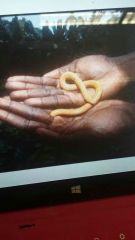
🔴Gymnophiona
|
-Caecilians, ~186 species
-Gymnophiona= "naked snake" -tropical, except Madagascar and Australia |
|
|
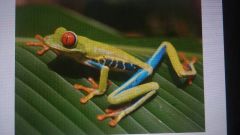
🔴Anura
|
-Frogs
- about 500 species -very wide distribution, huge range of habitats -stout body, protruding eyes, no tail |
|
|
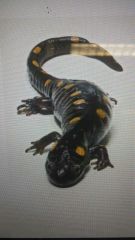
🔴Caudata
|
-Salamanders
- about 550 species -aquatic or terrestrial, usually found near water |
|
|
|
🔗Amniota
|
-Synapses + sauropsids (ex. reptiles including birds)
-characterized by amniotic egg -adaptation to life on land, free of the the need to return to water |
|
|
|
🔴Mammalia
|
-about 5400 species in 1200 genra
-Endotherms with fur, sweat glands, mammary glands, 4 chambered heart, etc. |
|
|
|
🔗Sauropsida
|
-Reptiles
-extremely diverse group that lives in a wide variety of habitats around he world -includes birds and other dinosaurs |
|
|
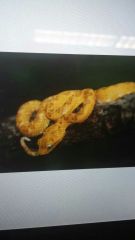
🔗Lepidosauria
|
-Reptiles w/overlapping scales
-includes squamates, and rhynchicephalians |
|
|
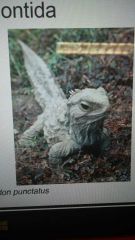
🔴Sphenodontida
|
-Tuataras
-2 species in 1 genus, New Zealand -very distinctive morphology, but lizard like -terrestrial, lives in furrows, tolerate cold temperatures -primarily insectiverous -long lived -small coastal islands, half live on Stephens island |
|
|
|
🔴Squamata
|
-Snakes and lizards
-more than 7000 species -large number of shared derived characters |
|
|
|
🔴Testudinides
|
-turtles
-Fossils from at least 210 mya -Anapsid skull -toothless jaw -ribs United with bony carapace (top of shell) -Plastron: bottom of shell |
|
|
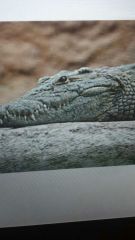
🔗Archosauria
|
-crocodiles, dinosaurs (including birds), and pterosaurs
|
|
|
|
🔴Crocodilia
|
-Alligators, caimans, crocodiles, gharials
-25 species -big size range -large rivers, swamps, lagoons, ocean |
|
|
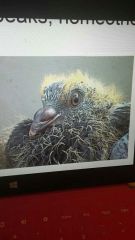
🔴Aves
|
-birds
-Feathers, flight beaks, homeothermy |
|
|
|
Biogeography
|
the study of historical processes that affect the geographic distributions of animal and plant species
|
|
|
|
Phylogeography
|
study of historical processes that affect the geographic distribution of genetic variation within species
|
|
|
|
Global Species Richness
|
the global number of species is a balance between 2 processes
|
|
|
|
Speciation
|
the formation of two species from one
|
|
|
|
Extinction
|
the death of a species
|
|
|
|
Net diversification
|
* speciation-extinction
*varies tremendously across clades |
|
|
|
Main Biogeographic Explanations
|
1. Vicariance: species ranges are explained by splitting due to the formation of barriers
2. Dispersal: species ranges are explained by movement (dispersal) into new areas |
2 definitions
|
|
|
Shared Derived Character
|
a trait that evolved in the ancestor of a group and is present in all its descendants.
|
|
|
|
Monophyletic
|
includes most common ancestors of a group of organisms and all descendents
|
|
|
|
Paraphyletic
|
includes most common ancestors but not all of its descendents
|
|
|
|
Polyphyletic
|
doesn't include common ancestor of all members of taxon
|
|
|
|
Anapsid
|
lacks opening/fenestrae in the temporal regions of the skull
|
turtles
|
|
|
Diapsids
|
has two opening in the temporal region of the skull
|
modern reptiles/crocodiles
|
|
|
Synapsid
|
1 opening in temporal region of the skull
|
mammals
|
|
|
External Fertilization
|
-egg and sperms are released outside the body and fertilized outside the body
-found in all frogs and some salamanders (and all fish) -affects patterns of mating and asexual selection |
|
|
|
Internal Fertilization
|
-sperm is directly deposited into the female, who produces eggs and fertilized them internally
-found in Carolinians, most salamander, 2 frogs, and all reptiles -requires a way to get sperm inside the females body |
|
|
|
IBD
|
-isolation by distance
-physical distance and barriers reduce gene flow between population s |
|
|
|
IBE
|
-isolation by environment
-adaptive differences or natural selection against dispensers limit gene flow between divergent habitats |
|
|

What does this graph explain?
|
it is both the physical distance and natural selection shape genetic variation with species of ANOLIS
|
|
|
|
How are phylogenetic tree created with 5 genes?
|
1 mtDNA and 4 nDNA
|
|
|
|
What Are the major points to collect evidence using phylogeography?
|
A) species geographic range, sequence DNA, genetic variation
B) study migration and gene flow across landscape and pop fragmentation |
|
|
|
Growth and Development 4 steps
|
1. Fertilization
2. Embryogenesis and pathogenesis 3. Metamorphosis 4. Egg hatching |
|
|
|
Fertilization
|
Involves the fusion of the spermatozoan and the ovum to form a zygote
-the ovum tends to be much larger in reptiles than in amphibians |
|
|
|
Ascaphis: Tailed Frogs
|
- the "tail" is a copulatory organ used for internal fertilization.
|
|
|
|
Which tetrapods group have internal fertilization?
|
Anura and Caudata
|
|
|
|
A) Yolk Content in Amphibians
B) Yolk Content in Reptiles |
A) -have small yolk amount
-hatch at earlier larval stage than reptiles B) -more yolk than amphibian ova -hatch as fully formed mini replica of parents |
|
|
|
What happens after fertilization?
|
-zygote undergoes cleavage to form blastula
-the boastful sets the stage for growth and patterning of the rest of the development |
|
|
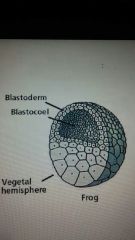
Amphibian Cleavage
|
-have HOLOBLASTIC cleavage
aka each early cell division produces equal size daughter cells -yolk concentration is highest at the bottom and cell division slows there |
|
|
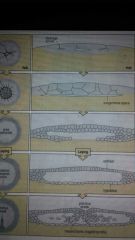
Reptile Cleavage
|
- have MEROBLASTIC cleavage
-cleavage furrow only partially penetrates into the yolk "incomplete cleavage" -flat disc for blastula |
|
|
|
Gastrulation
|
- 3 embryonic tissue layers formed
**Ectoderm, Mesoderm, Endoderm -formation of pharyngula stage- all basic organ systems are established |
|
|
|
Amphibian Gastrulation
|
-starts with a small indentation on the upper surface of the boastful
-cells migrate inward to form gut tube -the embryo elongated during neurulation: formation of neural tube -the pharyngula contains all yolk within its body as part of the digestive system |
|
|

Reptile Gastrulation
|
-Yolk sac is formed
-endodermal tissue grows outward and eventually encompasses the yolk mass -Ectoderm and Mesoderm grow upward into an amniotic sheath *outer 2 layers form Chorion: encases yolk and enbryo *inner 2 layers form amnion: encloses the embryo |
|
|
|
Morphogenesis
|
-is the biological process that causes an organism to develop its shape
-the final shape of an animal depends on the timing of morphogenesis |
|
|
|
A) What do body plans depend on?
B) Define Somites |
A) position and fate of somites
B) mesodermal segments that give rise to vertebrae |
|
|
|
Heterochrony
|
-changes in the timing and/or rate of growth of certain tissues
-Development can: *speed up, start earlier, and end later *slow down, start later, ends earlier * any combination of these |
|
|
|
2 Patterns of Heterchrony
|
1. Paedomorphosis
2. Peramorphosis |
|
|
|
Paedomorphosis
|
-occurs when a trait fails to develop to the extent observed in related species
-larval traits in "adult" individuals |
|
|
|
Peramorphosis
|
-when a trait develops further than the extent observed in related species
-LESS common in reptile and amphibians |
|
|
|
Amphibian Larvae
|
- "tadpoles" Are free living and most feed
-some depend on yolk stores -Castilian and salamander larvae resemble adults but with pharyngeal slits, gills, tail fins, and specialized larval detention |
|
|
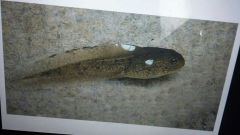
Tadpoles
|
-frog larvae are highly specialized
-long muscular tail -spherical body w/coiled intestine -some have external gills (replaced by internally gills in neobatrachian frogs) -oral disc encloses mouth -cartilaginous skeleton -keratinous mouthparts: jaw sheath, labia teeth |
|
|
|
Metamorphosis (Amphibians)
|
-transformation of amphibians from larva to a mini adult
-usually associated with transition from aquatic to terrestrial or semiterretrial lifestyle -changes occurs gradually but over a restricted tome period -initiated by hormone throxine |
|
|
|
Tadpoles Development
|
-can be classified into Grossner Stages
-Stages go from 1 (embryo) to 46 (metamorphosis) -hatching is at stage 17 |
|
|
|
Direct Development
|
-some amphibians have this
-hatchlings don't undergo metamorphosis *hatch as mini adults |
|
|
|
Reptiles in the Egg
|
-they need to maintain proper temperature, gas, and water balance
-maternal nest site selection can be key |
|
|
|
Reptile Hatching
|
-use a projection on the tip of the snout to break through the egg shell
-turtles, crocodylians, and sphenodon have a keratinized egg caruncle -squamates: egg tooth -most reptiles quickly exit the nest, although some turtles have delayed emergence |
|
|
|
where did many features of tetrapods evolve?
|
In aquatic habitat
*features turned out to be useful when transition to land occured |
|

